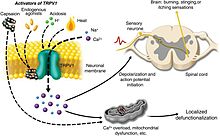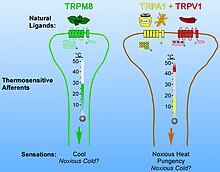Munari pack
A Munari pack ( Munari , Italian pack , Italian quick cure ) is a poultice with the ingredients kaolin , cayenne pepper , mustard oil and water . It is used as thermotherapy for pain and tension in the musculoskeletal system.
General
Munari applications are widespread in Austria and Italy. In Austria, the application is carried out by masseurs and physiotherapists.
application
In preparation, the ingredients (kaolin, cayenne pepper, mustard oil) are mixed with cold water to form a homogeneous paste, heated to approx. 50 ° C before use, then applied as a thin layer (2–5 mm) to a carrier material (usually paper) and placed on the patient on the body region to be treated. The body is then wrapped in linen towels or blankets for optimal heat storage. The duration of a treatment is between 15 and 20 minutes.
application areas
Due to the effects of cayenne pepper (capsaicin) and mustard oil, Munari can be used to treat pain, tension and degenerative diseases.
effect
Munari packs work like capsaicin patches. The main active ingredients are the capsaicinoids capsaicin and dihydrocapsaicin contained in cayenne pepper up to 1% . These enable the TRPV1 channel ( T ransient R preceptor P otential V anilloid subtype 1 ), resulting in an increased release of Ca 2+ leads; a nerve potential is developed. This process is then perceived as a burning, stabbing or itchy sensation. Long-term use of capsaicin leads to a reversible depletion of the neurotransmitter substance P , which triggers an analgesic effect as nociceptors are desensitized. The release of endorphins (the body's own "pain killers") is stimulated. The irritation of the nerve endings under the skin also leads to increased blood flow. Mustard oil is similar in effect to capsaicin and activated by cysteines that TRPA1 and TRPV1 channels ( T ransient R preceptor P otential A nkyrin Repeat 1 and V anilloid 1 ), Ca 2+ -permeable ion channels, the acute and inflammatory pain signals can perceive and trigger .
Individual evidence
- ^ Job description and special professional duties of the medical masseur - Medical Masseur- und Heil Masseurgesetz . Website of the Austrian Federal Chancellery - legal information system. Retrieved July 21, 2014.
- ↑ Italian quick cure (Munari pack) ( page no longer available , search in web archives ) Info: The link was automatically marked as defective. Please check the link according to the instructions and then remove this notice. . Website of the Social Insurance Institution for Business. Retrieved September 22, 2015.
- ↑ a b c Gerda Vacariu, Othmar Schuhfried, Marta Korpan: Physical therapy and rehabilitation for pain syndromes in the musculoskeletal system. In: Compendium of Physical Medicine and Rehabilitation. 3. Edition. 2013, ISBN 978-3-7091-0467-5 , p. 357.
- ↑ Capsicum (paprika) - areas of application . Monograph BGA / BfArM (Commission E). February 1, 1990. Issue 22A. ATC code M02AB. Retrieved July 21, 2014.
- ↑ P. Anand, K. Bley: Topical capsaicin for pain management: therapeutic potential and mechanisms of action of the new high-concentration capsaicin 8% patch. In: Br J Anaesth. 107 (4), Oct 2011, pp. 490-502. doi: 10.1093 / bja / aer260 . Epub 2011 Aug 17. PMID 21852280
- ^ Substance capsaicin - documents scripts . Website of Prof. Dr. Peter Bützer. Retrieved July 21, 2014.
- Jump up ↑ M. Gees, YA Alpizar, B. Boonen, A. Sanchez, W. Everaerts, A. Segal, F. Xue, A. Janssens, G. Owsianik, B. Nilius, T. Voets, K. Talavera: Mechanisms of transient receptor potential vanilloid 1 activation and sensitization by allyl isothiocyanate. In: Mol Pharmacol. 84 (3), Sep 2013, pp. 325-334. doi: 10.1124 / mol.113.085548 . Epub 2013 Jun 11. PMID 23757176



